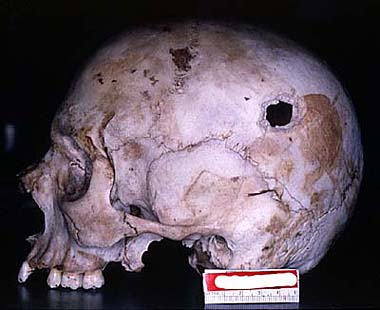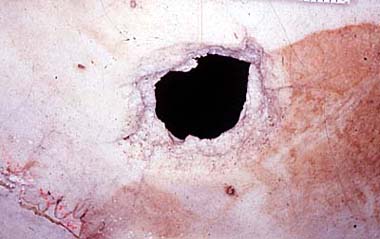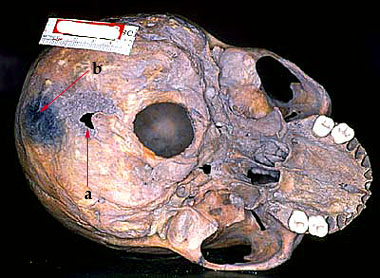Photo courtesy of Rhine, p. 162
This
is an exit wound on the forehead of a young woman who was killed on her
honeymoon. Note the classic external beveling that is seen on all
exit wounds.
Photo courtesy of Rhine, p. 162
 This
is another exit wound. The entrance wound from this bullet is shown
under the entrance wound section (second
photo). The size of this exit would is roughly twice the size
of the entrance wound.
This
is another exit wound. The entrance wound from this bullet is shown
under the entrance wound section (second
photo). The size of this exit would is roughly twice the size
of the entrance wound.
Photo courtesy of OsteoInteractive at http://www-medlib.med.utah.edu/kw/osteo/index2.html
 This
is a close up of the exit wound above. From this perspective it is
easy to see the missing portion of outer table.
This
is a close up of the exit wound above. From this perspective it is
easy to see the missing portion of outer table.
Photo courtesy of OsteoInteractive at http://www-medlib.med.utah.edu/kw/osteo/index2.html
 This
exit wound's associated entrance wound is also shown in the entrance
wound section (first photo). The hole marked (a) is the exit
wound and it is located in the occipital bone. The copper stain marked
by (b) was left by the bullet when it became lodged in the scalp (penetrating
and perforating type of injury). This type of wound is common due
to internal ricochet which occurs 10-25% of the time, depending on the
caliber of the bullet. The most common route taken by the bullet
in these cases is through the brain to the other side of the skull where
it strikes and is then deflected parallel to the internal table.
This
exit wound's associated entrance wound is also shown in the entrance
wound section (first photo). The hole marked (a) is the exit
wound and it is located in the occipital bone. The copper stain marked
by (b) was left by the bullet when it became lodged in the scalp (penetrating
and perforating type of injury). This type of wound is common due
to internal ricochet which occurs 10-25% of the time, depending on the
caliber of the bullet. The most common route taken by the bullet
in these cases is through the brain to the other side of the skull where
it strikes and is then deflected parallel to the internal table.
Photo courtesy of OsteoInteractive at http://www-medlib.med.utah.edu/kw/osteo/index2.html